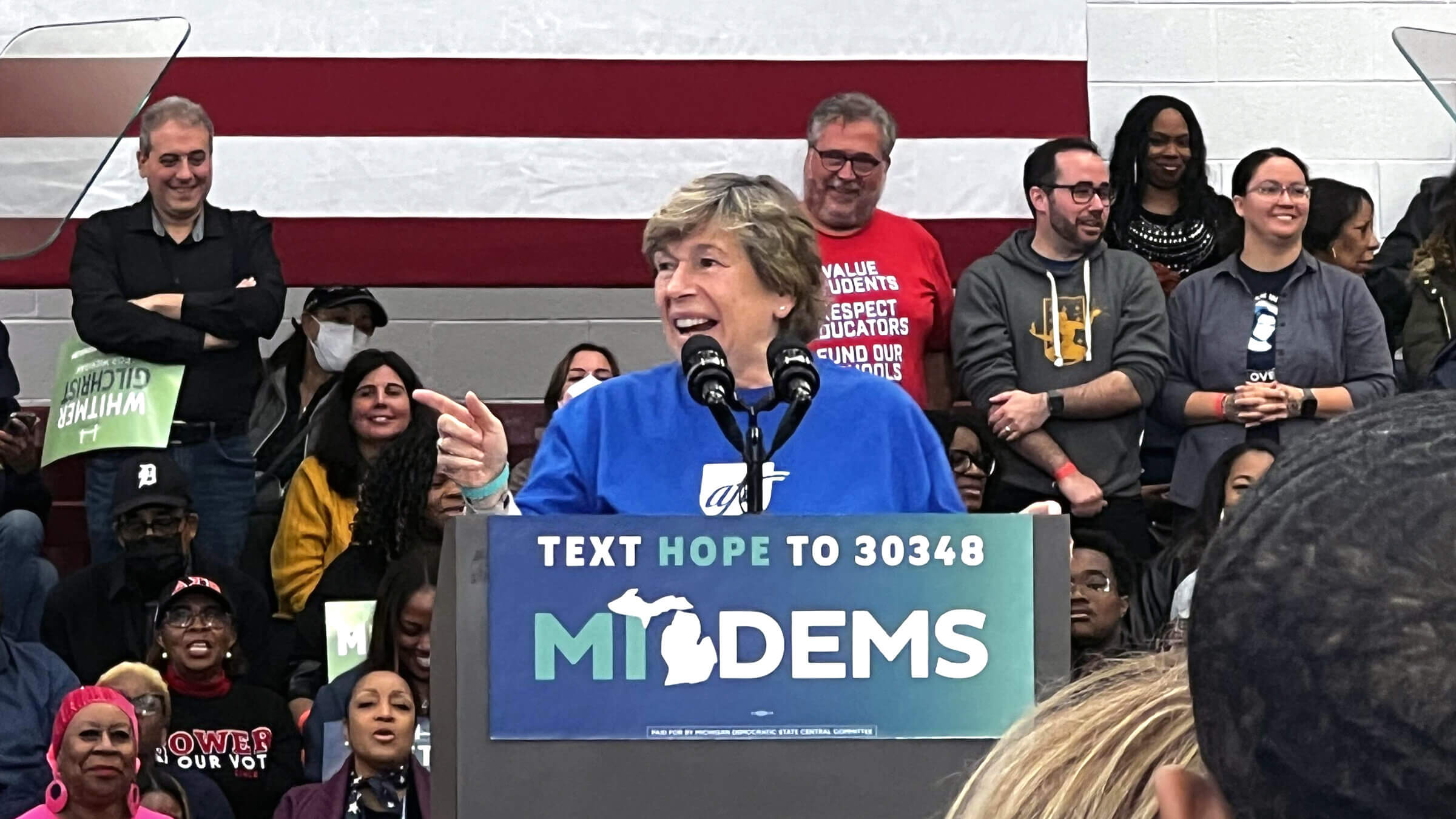Voting for democracy and a better life
Americans rejected extremism and supported uniters and problem-solvers

Weingarten in Detroit on Oct. 29, on the AFT Votes bus tour.
In the leadup to the midterm elections, pundits predicted a red wave, even a tsunami, based on polls, historical precedent, and steep gas and grocery prices. But I had my doubts. I spent the weeks before the elections talking to voters and traveling on the AFT Votes bus, rolling through a dozen states with more than 50 stops. In a year when kitchen table issues, democracy and our freedoms were on the ballot, many people told me that the elections came down to a choice between, on the one side, election deniers and extremists stoking fear, and on the other, problem-solvers working to help the country move forward. Many races were close, but Americans turned the tide from a red wave to a swell of support for progress and problem-solvers.
The same was true when it came to education. In a year when extremists sought to wage culture wars in our schools, rather than focus on the supports young people need to recover and thrive, election results showed a deep well of support for the promise and potential of public education and the investments parents want to help their kids. Voters in California, Massachusetts, New Mexico and even Florida passed ballot measures and funding boosts for public schools.
Young people in particular turned out in historic numbers to vote for their future. They supported candidates committed to combating the climate crisis, reducing gun violence, protecting reproductive and LGBTQIA+ rights, and fighting for shared prosperity and student debt relief. In Florida, 25-year-old Maxwell Alejandro Frost ran on these issues and became the first Generation Z member elected to Congress.
The battle for control of Congress consumed a hefty share of Americans’ attention. But gubernatorial races carried especially high stakes this year given candidates’ diverging stances on issues ranging from education to crime to abortion access to the integrity of future elections in those states. Democrats, with their support for public education, economic security and democracy, had their best midterms for governors since 1986.
In Michigan, Gov. Gretchen Whitmer made the largest investment in K-12 education in state history and closed the school funding gap. She expanded low- and no-cost child care for families. She helped create nearly 25,000 automotive jobs, championed reproductive freedom, and is delivering on her promise to “fix the damn roads,” with bonds for roads and funding to repair 100 bridges. Oh, and she evaded a kidnapping plot. Meanwhile, Whitmer’s opponent, Tudor Dixon, with endorsements from Donald Trump, Betsy DeVos and the National Rifle Association, ran on a platform of culture wars, school vouchers and opposition to abortion. Michigan voters responded by favoring a Democratic trifecta—the governorship and the state House and Senate.
In Wisconsin, Gov. Tony Evers, a longtime educator, made historic investments in Wisconsin’s long-underfunded public schools and increased funding for special education and higher education. He worked to lower the cost of prescription drugs for Wisconsinites. And he vetoed GOP bills to expand concealed-carry rights and championed efforts to repeal Wisconsin’s 1849 law criminalizing abortion. Evers’ opponent, Trump-endorsed Tim Michels, called increasing school funding the “definition of insanity” and opposed red flag gun laws and reproductive freedom. Evers won.
In New York, Gov. Kathy Hochul made record investments in healthcare, education, infrastructure and the environment. She won $100 million to help schools deal with pandemic fallout, including mental health services. She signed nation-leading pro-choice legislation and funded community-based gun violence intervention programs. Her opponent, NRA- and Trump-endorsed Lee Zeldin, pledged to restrict how race is taught in schools and supported education vouchers. In Congress, Zeldin voted to defund Planned Parenthood and against the assault weapons ban. Hochul won.
In Arizona, Katie Hobbs, a former social worker serving as Arizona’s secretary of state, focused on ensuring reproductive rights, preserving democracy, supporting public education (including more school counselors) and commonsense gun safety. Opponent Kari Lake, a Trump-endorsed election denier, favored school vouchers, opposed social and emotional learning, and rejected any restrictions on gun ownership. Hobbs won.
Voters made similar choices for governor in Colorado, Kansas, Maine, Maryland, Massachusetts, New Mexico, Oregon and Pennsylvania.
And while extremists’ calling card this year has been to attack—whether it’s immigrants or transgender kids or teaching honest history—Congress is on the cusp of passing a bipartisan bill to respect and protect marriage, including interracial and same-sex marriage.
Our country remains deeply divided, and the high cost of living is still a top concern. But Americans defied historical midterm expectations and overwhelmingly rejected extremism; they supported uniters and problem-solvers, and they voted to protect their freedoms and democracy. Many challenges remain, but Americans are united by a powerful bond: We all want a better life for ourselves and our families.













